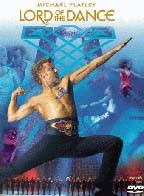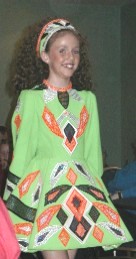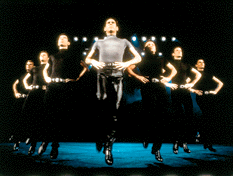![]() Irish dancing: types of dances
Irish dancing: types of dances
 Irish dancing includes a wide range of different types of dancing, including solo, pair and group dances. Round and Long dances are group dances, requiring a minimum of four dancers depending on the dance. Round dances are known in step dancing as figure dances (e.g., six-hand reel, eight-hand reel, four-hand jig). There are four basic Irish step dances (solos): reel, (light) jig, slip jig and hornpipe. There are, of course, many many variations of reel, light jig, slip jig and hornpipe steps. Each dancing school has its own versions of the steps. Irish dance has a distinctive, recognizable timing. For those who are musically inclined and care about the timing of these dances: the reel is in 2/4 time; the light jig is in 6/8 time; the slip jig is in the complex 9/8 time; the hornpipe is also in 2/4 time, although with a different structure than that of the reel. The general public has been introduced to Irish dance relatively recently through stage productions such as Riverdance or Lord of the Dance [see photo]. They are unaware that the demanding step dancing performance they are seeing is only one form of Irish dance. But Irish dance is not carried by the single thread of its solo performance form. It is a rich tapestry of interwoven solo and social dance forms: the solo step dances and set step dances, the ceili dances that directly reflect several of the forms and movements of the step dances, the set dances that also reflect many of these same movements but retain different aspects from those emphasized in ceili dances, and even the waltzes and other couples dances which are danced by the Irish in forms that reflect the cultural dance heritage.
Irish dancing includes a wide range of different types of dancing, including solo, pair and group dances. Round and Long dances are group dances, requiring a minimum of four dancers depending on the dance. Round dances are known in step dancing as figure dances (e.g., six-hand reel, eight-hand reel, four-hand jig). There are four basic Irish step dances (solos): reel, (light) jig, slip jig and hornpipe. There are, of course, many many variations of reel, light jig, slip jig and hornpipe steps. Each dancing school has its own versions of the steps. Irish dance has a distinctive, recognizable timing. For those who are musically inclined and care about the timing of these dances: the reel is in 2/4 time; the light jig is in 6/8 time; the slip jig is in the complex 9/8 time; the hornpipe is also in 2/4 time, although with a different structure than that of the reel. The general public has been introduced to Irish dance relatively recently through stage productions such as Riverdance or Lord of the Dance [see photo]. They are unaware that the demanding step dancing performance they are seeing is only one form of Irish dance. But Irish dance is not carried by the single thread of its solo performance form. It is a rich tapestry of interwoven solo and social dance forms: the solo step dances and set step dances, the ceili dances that directly reflect several of the forms and movements of the step dances, the set dances that also reflect many of these same movements but retain different aspects from those emphasized in ceili dances, and even the waltzes and other couples dances which are danced by the Irish in forms that reflect the cultural dance heritage.
Ceili Dancing
History
 Ceili dances represent an informal tradition of dance that is common to much of humanity since prehistory. Many are structured as sword dances, round dances, line dances, and progressive line dances. The Normans have been credited for introducing the round dance into Ireland around the 12th century. The "rince fada" (long dance) is actually a family of dances, one of which was described in the end of the 17th century as performed by "three persons moving abreast, each of which held the end of a white handkerchief, followed by the rest of the dancers in pairs". The Gaelic Revival in Ireland in the late 19th century destroyed the practice of dancing these dances so effectively that when the Gaelic League decided to resurrect them in the 1920's, they had generally been lost and new dances had to be codified. Many of the modern ceili dances have known authors. For example, the "Fairy Reel" was composed by An t-Athair Ó Flannagáin around 1930, to a tune written by Neil Gow for the Fife Hunt Ball in Scotland in 1802. The Irish word céili originally referred to a gathering of neighbours in a house to have an enjoyable time, dancing, playing music and storytelling. Today it refers to an informal evening of dancing. Céilis are held in large towns and country districts where young and old enjoy together group dances. The céili can be traced back to pre-famine times, when dancing at the cross-roads was a popular rural pastime. These dances were usually held on Sunday evenings in summer when young people would gather at the cross-roads. The music was often performed by a fiddler seated on a three legged stool with his upturned hat beside him for a collection. The fiddler began with a reel such as the lively "Silver Tip", but he had to play it several times before the dancers joined in. The young men were reluctant to begin the dance but after some encouragement from the fiddler, the sets of eight filled up the dancing area.
Ceili dances represent an informal tradition of dance that is common to much of humanity since prehistory. Many are structured as sword dances, round dances, line dances, and progressive line dances. The Normans have been credited for introducing the round dance into Ireland around the 12th century. The "rince fada" (long dance) is actually a family of dances, one of which was described in the end of the 17th century as performed by "three persons moving abreast, each of which held the end of a white handkerchief, followed by the rest of the dancers in pairs". The Gaelic Revival in Ireland in the late 19th century destroyed the practice of dancing these dances so effectively that when the Gaelic League decided to resurrect them in the 1920's, they had generally been lost and new dances had to be codified. Many of the modern ceili dances have known authors. For example, the "Fairy Reel" was composed by An t-Athair Ó Flannagáin around 1930, to a tune written by Neil Gow for the Fife Hunt Ball in Scotland in 1802. The Irish word céili originally referred to a gathering of neighbours in a house to have an enjoyable time, dancing, playing music and storytelling. Today it refers to an informal evening of dancing. Céilis are held in large towns and country districts where young and old enjoy together group dances. The céili can be traced back to pre-famine times, when dancing at the cross-roads was a popular rural pastime. These dances were usually held on Sunday evenings in summer when young people would gather at the cross-roads. The music was often performed by a fiddler seated on a three legged stool with his upturned hat beside him for a collection. The fiddler began with a reel such as the lively "Silver Tip", but he had to play it several times before the dancers joined in. The young men were reluctant to begin the dance but after some encouragement from the fiddler, the sets of eight filled up the dancing area.
Structure
The modern Ceili dance form was codified early in this century [20°] by the Gaelic League who were simultaneously establishing the form to be used for step-dancing competitions. As well as the often noted "hands at the sides" aspect, ceili dance today emphasizes the height, turn-out, dancing on the toes (not the same as the ballet stance), extension of leg and foot, long reach and quick movements seen in the step dances as well, but tends to de-emphasize the use of battering and foot percussion.
Step Dancing
History
 Irish step dancing evolved as the creation of Irish dancing masters, subsequent to their appearance in the late 18th century. Dancing masters would often travel from town to town, teaching basic dancing steps to those interested and able to pay for them. Since the basic folk dances had been done for centuries in their absence, one must suspect that their appearance was motivated by a desire to learn the "upscale" dance styles then beginning to be introduced from France. The dance masters often paraphrased these dances to fit the traditional music available and, in doing so, laid the basis for much of today's traditional Irish dance--ceili, step and set. The dance masters taught steps, the 8-bar units out of which most Irish traditional dance is constructed. The steps involved both the movements needed for various dances and the foot percussion, called battering, used for rhythmic emphasis. Competitions were often held in which the demonstrations of steps by masters were performed on a table-top or similar small stage. In fact, dancing in a limited space was viewed as such an important aspect of the style that one of the greatest tributes to be paid to a dancer was to note that they could "dance on the top of a plate."
Irish step dancing evolved as the creation of Irish dancing masters, subsequent to their appearance in the late 18th century. Dancing masters would often travel from town to town, teaching basic dancing steps to those interested and able to pay for them. Since the basic folk dances had been done for centuries in their absence, one must suspect that their appearance was motivated by a desire to learn the "upscale" dance styles then beginning to be introduced from France. The dance masters often paraphrased these dances to fit the traditional music available and, in doing so, laid the basis for much of today's traditional Irish dance--ceili, step and set. The dance masters taught steps, the 8-bar units out of which most Irish traditional dance is constructed. The steps involved both the movements needed for various dances and the foot percussion, called battering, used for rhythmic emphasis. Competitions were often held in which the demonstrations of steps by masters were performed on a table-top or similar small stage. In fact, dancing in a limited space was viewed as such an important aspect of the style that one of the greatest tributes to be paid to a dancer was to note that they could "dance on the top of a plate."
Structure
The codification of style that defines modern step dance took place in the 1920's and provided a basis for judging of competitions. Although none can deny the great response and popularity induced by competitions, they also tend to push style into emphasizing extremes in preferred characteristics rather than overall balance of effect. The early (sean-nos) dance style for step emphasized a close form and posture - legs kept together, no high kicks, little or no turning and, obviously, no travelling. The preferred style for competition step-dancing changed through the 1950's and 1960's. The availability of lorries, then small stages in halls, and then larger stages, especially in the larger cities made it possible to perform the travelling steps, circular lead-in's, sevens-and-threes, and turns we see as a characteristic of modern step-dance.
Set Dancing
History
The Irish Set Dances (as distinguished from the set step dances) are the evolutionary descendants of the Quadrilles danced at the French court in the late 18th and early 19th century and other related dances from Scotland, and elsewhere. These dances were brought to Ireland and taught by early dancing masters who adapted them, to Irish traditional music and modified and elaborated them to show off their dancing prowess. In time, various regions of the country retained and danced the local "set" at crossroads and in homes, even when the Catholic Church used the Public Dance Hall Act of 1935 to try to stamp them out. It survived best in those parts of the country that held most strongly to their traditions. Although the ceili dances were held by some to be more Irish, the only dances that could be found in places like the Kerry gaeltachta were the sets. The Comhaltas Ceoltóirí Éireann and the Gaelic Athletic Association began to sponsor competitions in the 1950's and 1960's and the 1980's and 1990's have seen a large-scale revival of the popularity of set dancing. Today, we can count approximately 100 different sets gathered from localities in all parts of Ireland, although it has been said that the dancing only four of them has never lapsed: the Caledonian, Connemara, Cashel, and Sliabh Luachra.
Structure
Set dances are danced by four couples, generally (but not always) arranged on the sides of a square. They are generally divided into several (usually 5 or 6, but ranging from 2 to 9) "figures". Set dances are danced flat on the feet, and generally avoid the leaps and travelling movements of the ceili dances, although the feet of some of the dancers from Cork and Kerry are only occasionally found near the floor. Unlike the ceili dances, set dances retain and feature strong regional variations in the style of the dance. Sets from Cork and Kerry lean heavily on the jigs and polkas played so well by the musicians of these counties, while the sets from Clare feature the reels of which those people are so fond. Sets, like the Clare Lancers, from North Clare are danced with a smooth, gliding styl e while those from other parts of Clare are da nced with battering reminiscent of that introduced by the dancing masters of old into their step-dancing performed on small platforms.
![]()